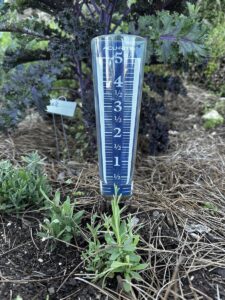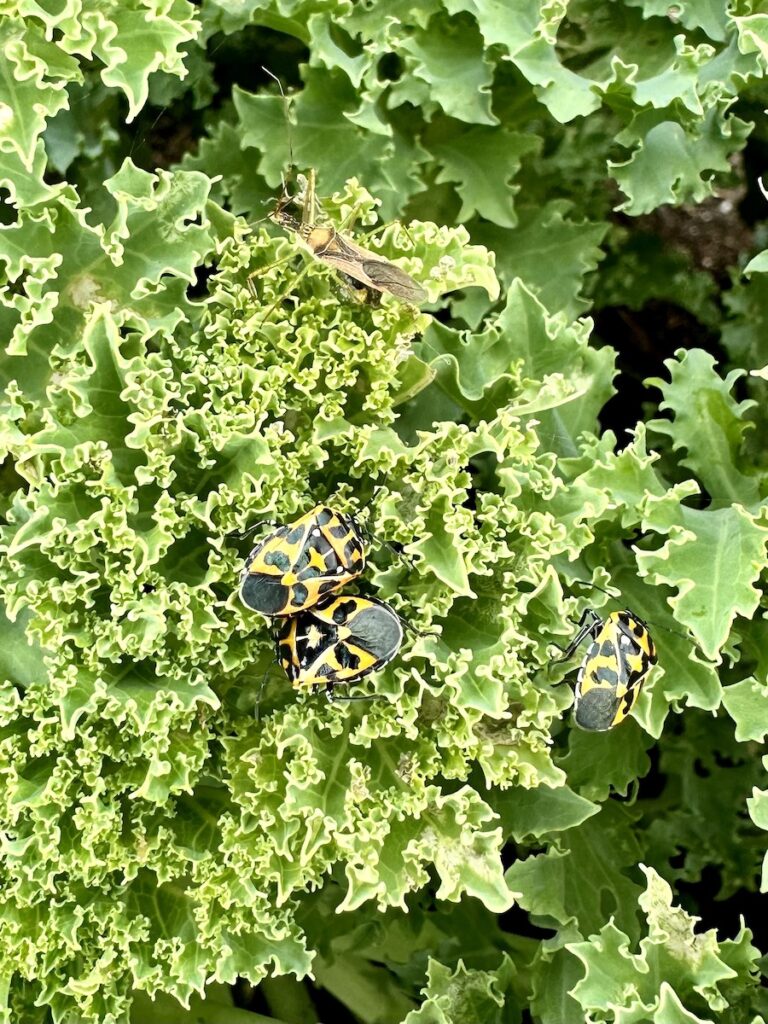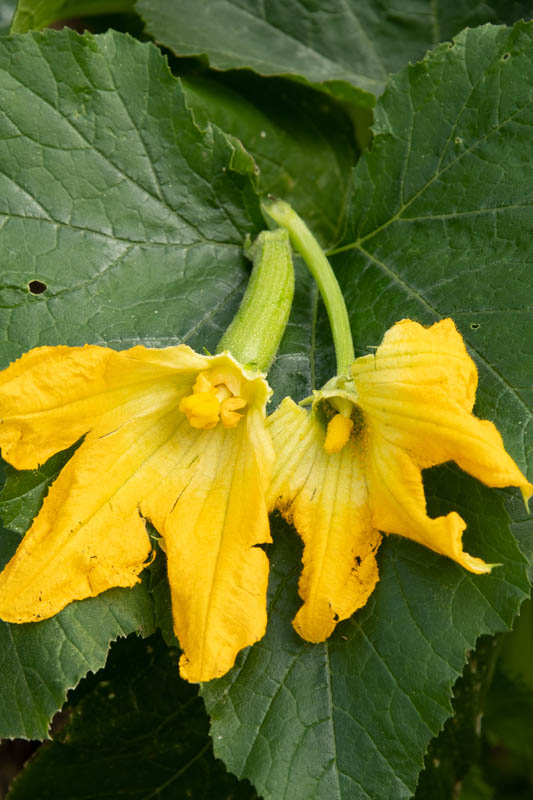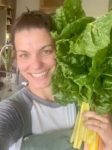
Example of a Rain Gauge in an Austin Vegetable Garden
Enjoy the April Vegetable Garden!
All warm weather vegetables can be planted during the month of April. Remember to choose vegetable varieties that grow in Central Texas.
Seeds or Transplants?
You can find almost all vegetables available to purchase as transplants for the April vegetable garden. However, you can save money by planting seeds when possible. Some vegetables like tomatoes, eggplant, and peppers need to be transplanted instead of planting seeds to allow the crops to mature before hot weather sets in and extends the productive period of many vegetable crops.
Monitor Irrigation
Remember to give your newly planted transplants or seeds enough water to wet the soil to a depth of at least 6 inches. You can stick your finger or a popsicle stick into the soil to make sure its moist. Water your newly planted vegetables daily for approximately the first two weeks to help the plants establish roots. After that, most gardens require about 1 inch of rain or irrigation per week during the growing season. You can place a measure cup in your garden where your irrigation releases water or leave a rain gauge in your garden to measure how much water enters your garden.
Use Mulch
Once your plants are established, it is recommended to always use mulch. Mulch limits weed growth, regulates soil temperature, and conserves moisture in the soil.
April Vegetable Garden Checklist for Austin
Examine your garden often to keep ahead of potential problems. April is one of the most fun months for gardeners because most of the summer pests are not out yet and the weather is tolerable. So have fun!
FERTILIZE
- Spring is Austin’s rainy season and it will wash out liquid fertilizers; switch to granules unless the weather is dry.
- Fertilize corn when it is one to two feet tall toward the end of the month.
- Apply fertilizer to tomatoes and other flowering vegetables when the fruit first appear. Continue to fertilize every 3-4 weeks until the plant stops producing in the heat. Start with granules then switch to water-soluable fertilizer as the heat arrives.
- The amount and timing of fertilizer needed for non-fruiting vegetables varies according to the type of vegetable planted for the April vegetable garden. If you don’t have soil test results to follow, get specific recommendations from the Easy Gardening series. In general, most should only be fertilized at the beginning of the growing season. If you are growing cut-and-come again plants like salad greens, collards, or spinach, you can fertilize after you harvest. Others, like sweet corn, require more nutrition. Too much fertilizer leads to salt build up and drought stress.
- For more information on fertilizer, check out this fact sheet.
WATER
- Make sure you have audited your irrigation system. If you are using a drip system, confirm that all the emitters are working. If they seem to be plugged, replace the emitter or the drip line. It’s really hard to get them unplugged and functioning properly.
- Use the TexasETNetwork site to determine irrigation needs. Click on the Crop Calculator to select individual crops and their growth stage for irrigation recommendations based on actual weather data.
- When you irrigate, water deeply. Dig down into the soil 6” to see if the soil is moist. If not, adjust your irrigation schedule to water longer or more frequently for your soil type.
- With water restrictions already in place throughout the county, click here to read more tips on efficient irrigation.
PLANTING SCHEDULE FOR APRIL VEGETABLE GARDEN
Seeds
-
- Beans, snap and lima
- Beets
- Corn
- Cantaloupe
- Cucumber
- Greens, warm season
- Okra
- Peas, Southern
- Pumpkin
- Squash, summer
- Squash, winter
- Watermelon
Seeds or Transplants
-
- Swiss Chard
- Tomatoes
Transplants
-
- Eggplant
- Peppers
- Potato, sweet (slips)
HERBS
- Add Thai, African Blue, or Holy basil to your vegetable beds and let them flower. They help attract pollinators and beneficial insects.
SOIL
- Mix in compost to the top layers of soil
- Mulch well around your established vegetable plants. Mulch will help retain moisture, regulate soil temperatures as it starts to get hot, and over time, will turn to compost.
- Be careful not to bury plants with mulch because you still need to get water to the root zone. Pull away the mulch if you are hand watering, then replace when done. If drip irrigating, put the emitters under the mulch or pull mulch away from the drip zone.

Two Harlequin Bugs and a Praying Mantis on Kale.
DISEASES/PESTS TO LOOK FOR
- Watch for aphids on tender new growth. Wash them off with water or use insecticidal soap.
- Harlequin bugs (Murgantia histrionica) will appear on mustard, collards, kale, arugula, and other brassica crops as the temperatures warm. Rather than spraying, cut plants at soil level then compost the tops since they are at the end of their harvesting season.
- Sooty mold, black spot, and powdery mildew may also start to appear. Consult the Grow Green FAQ sheets for least toxic solutions.
- Watch out for fire ants, they become more active after a rain and love to move into vegetable beds. If they aren’t in an area that will cause harm to people, you can leave them alone and enjoy their soil aeration work.
- Caterpillars are out; treat only those plants are not larval hosts to our native pollinators. You can see a list of Austin butterfly plants here.
- Snails can be a problem in the April vegetable garden. or if you are over irrigating. The best stratgegy is to pick them off by hand. Keeping garden beds weed free helps to eliminate hiding places.
MAINTENANCE
- Gather oak leaves and tassels that have dropped from trees onto your driveway or patios. It will all come in handy as mulch and they are relatively free of weed seeds if gathered from hardscapes.
- Cultivate around plants to control weeds, break up crusty soil and provide aeration.
- As tomatoes grow, place stems inside of cages. It’s much easier to do when they are small and flexible.
- Thin transplants and seedlings as they grow. Adequate root development and plenty of air circulation helps plants fend off disease. It’s also easier to spot pests.
- Keep your potatoes mulched or hilled with soil to protect the tubers from sunlight and to encourage the lower portion of the plants to develop tubers laterally along the stem.
- Don’t worry if your potatoes start to bloom – it doesn’t impact tuber development.
- Hill up the soil or mulch around corn to help stabilize it and keep it from blowing over.
- Maintain mulch around your garlic and onions to preserve moisture. Make sure you are irrigating the soil and not the mulch. The bulbs are rapidly developing and need plenty of water.
- Let your cool season herbs like cilantro, dill, and parsley bolt and flower. They are a favorite pollen source for beneficial insects.
- Clean your garden tools after each use. Try not to cross contaminate by using tools in different gardens or on different plants.
- Take inventory of your pesticides and liquid amendments. Most of these products need to be stored at temperatures below 90° F. Make note and use up what you safely can if summer heat is going to be an issue in your shed or garage.
- Keep notes and records on garden activities; keep a calendar so you know when things were planted, when things were last watered/ when it rained, when bugs appear in your garden (to prepare for next year), and when vegetables are expected to fruit according to the seed packet or plant label.

An immature squash develops at the base of the female bloom on the left.
HARVEST
Winter Garden
- Continue to harvest the remains of your winter garden before temperatures get too hot for them (cabbage, broccoli, Brussel Sprouts, kale, collards, spinach, lettuce). You can eat the leaves on all of these plants or freeze them for soups and smoothies.
Green Beans
- Green beans should be coming on fast and furious this month and you may need to pick them daily.
Onions:
- Harvest if you are within the window of the time guideline on your seed packet. It is a good habit to keep garden notes, keep a garden calendar, or make a note on the plant label in your garden.
- When the tops begin to turn yellow and fall over.
- Onions do not have to be a certain size unless you plan on storing them. Pick them as you need them.
Carrots:
- Carrot greens above the ground are approximately 10-12 inches tall (Carrot greens are edible.)
- When carrots are exposed to sunlight, they can develop a green pigment and become bitter. Keep them covered and harvest any that are 3/4 to 1-inch in diameter.
Beets:
- Clear the soil around the base of one or two of your beets and without uprooting the plants, take two fingers and make a circle around the base of the beet plant, exposing the top third of the plant. If the beet is wide and large enough for your preference, then you can pull it out. If it is too small for harvest, gently push some soil and/ or compost back on top of the beet and give it a little watering. Wait a few weeks before testing them again.
- Beet greens are edible. Use scissors to snip off a few to add to salads or stir-frys. Harvesting just a few leaves has minimal impact on root growth.
Radishes
- What is growing above the soil usually mimics what is growing below the soil so when your radish greens start growing above 6 inches, take that as a sign that the radish below soil is also growing and reaching maturity. (Radish greens are edible.)
- Radishes do not grow much more once the top of the root pops up above the soil.
Squash
- If you are growing squash or zucchini, you can harvest the flowers and have squash blossom quesadillas, fried squash blossoms stuffed with cheese and herbs, or sautéed squash blossoms with pasta and olive oil. You can eat both male and female flowers.
- Leave enough female flowers on the plant to produce the amount of fruit you desire, or pick the female flower once the fruit has formed.
- Always leave a few male flowers for pollination. Male flowers have a thing straight stem and the female flowers have miniature fruit just below the flower petals.
Additional Resources
Weather Strategies for Austin Gardens
Watch the Vegetable Gardening in Central Texas Webinar
Vegetable Planting Calendar (Español, 繁体中文)
Recommended Vegetable Varieties for Travis County
Easy Gardening Series Detailed tips from Texas A&M University AgriLife Extension on specific crops and practices.
Vegetable Gardening in Austin Resource hub for all things vegetables for Travis County
Plant Rotations, Successions and Intercropping
Monthly Gardening Calendar for Austin and Central Texas
Sustainable Food Center Farmers Markets
About Paula Wolfel
 Paula Wolfel joined the Travis County Master Gardener program in 2022 and has taken extra training to become a vegetable specialist. She grew up in the suburbs of Chicago learning how to garden from both her father—a Sicilian vegetable and fruit tree gardener—and both her grandmothers, and then spent years in Virginia gardening. Paula loves gardening because she finds it to be a grounding force- it gets her out of her head and into the present. She loves the pride that comes with cooking a meal for her family with every ingredient coming from her garden… and then the humility she feels when she loses an entire crop because of Mother Nature. She finds gardening to be wisdom, lessons, best practices passed down generation to generation, season to season and hopes to share that with you.
Paula Wolfel joined the Travis County Master Gardener program in 2022 and has taken extra training to become a vegetable specialist. She grew up in the suburbs of Chicago learning how to garden from both her father—a Sicilian vegetable and fruit tree gardener—and both her grandmothers, and then spent years in Virginia gardening. Paula loves gardening because she finds it to be a grounding force- it gets her out of her head and into the present. She loves the pride that comes with cooking a meal for her family with every ingredient coming from her garden… and then the humility she feels when she loses an entire crop because of Mother Nature. She finds gardening to be wisdom, lessons, best practices passed down generation to generation, season to season and hopes to share that with you.
